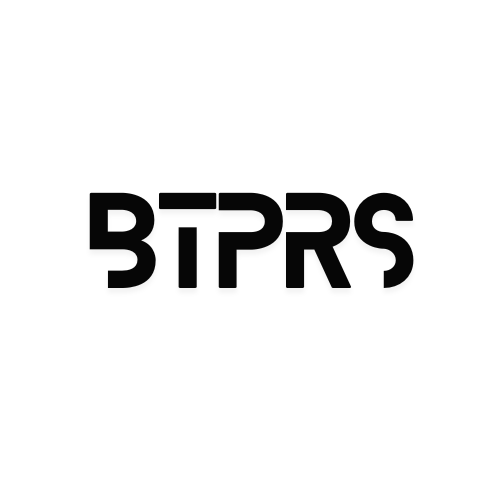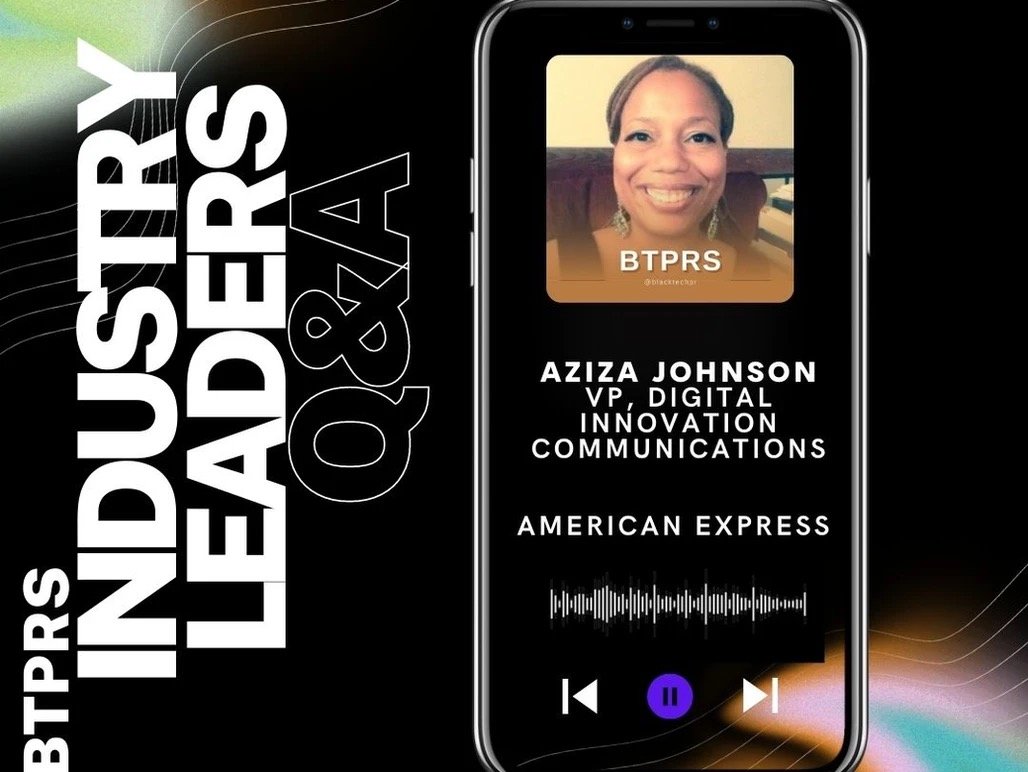BTPRS Industry Leaders Q&A: Aziza Johnson, AmeX – VP, Digital Innovation Communications
As global champions of diversity across technology and venture capital, we’re thrilled to introduce our new Q&A series highlighting senior leaders in communications and their impactful journeys. We celebrate their creative excellence, innovative ideas, and valuable experiences – to inspire the next generation of rising PR professionals and leaders to succeed and chart their own paths.
We had the pleasure to sit down with Aziza Johnson, Vice President of Digital Innovation Communications at American Express (AmeX). In this role, Aziza focuses on digital innovation and supports many of the business units that have digital innovation underpinning their work. Her larger charge at AmeX is to enhance the reputation of the company as a digital innovator — which includes anything from how they use artificial intelligence/machine learning to better serve customers; or how they develop digital products and govern data. Additionally, Aziza further oversees how AmeX communicates about Web3. As a whole, she promotes why Amex is one of a kind at developing products and using technology to do what they do best — “deliver world-class customer service.”
In our first edition of the BTPRS Industry Leaders Q&A series, Aziza shares more on her early beginnings where she helped amplify the revolutionary video calling platform Skype, provides self-care tips in the PR space, and gives key advice for new leaders.
BTPRS: What has been your journey in the communications space? – Is there anything initially that drew you to the field?
Aziza: I started promoting student productions in college and after graduating – I knew I didn’t want to go the typical route toward consulting or even investment banking. For two years, I worked in the general business sector and then quit and decided to move back to New York. After taking a step back and recalling the enjoyment of promoting student productions in college, I decided to look into public relations. I got a job at a publishing company, Little Brown, and Company, where I was a publicity assistant. This role cemented my interest in PR and from there I moved on to an agency. I believe everyone should start their communications career at a PR agency because it really gives you the foundation and basic skills you need to do the job (e.g., writing a pitch, thinking about story angles, communicating with reporters). This was a smaller PR agency so I had the opportunity to pitch/secure stories, conduct media trainings and do client management – across various restaurants, authors, and even the Mystery Writers of America.
After a few years, I moved to a bigger agency where I focused on eBay, particularly their fashion vertical. At the time, I worked to establish eBay as a place where you could buy designer goods that were authentic – and position them as a go-to place for people to find great fashion, instead of thinking of Nordstrom or Macy’s. In this role, I worked for the first time on running a spokesperson program and how to land big stories. Also during this time, eBay purchased Skype and I had the opportunity to work on that account – which changed the focus of my communications career to consumer technology. From there, I worked with a number of consumer technology clients and went to another agency that was solely focused on technology. I spent 7 years there. Then I was offered an opportunity to work with American Express – where they were looking for someone to help with their communications around technology and innovation. For communications professionals, it’s always great to get both agency and in-house experience in your career.
BTPRS: What is one characteristic that you feel every leader should possess?
Aziza: Empathy is really important, and as a leader – you have to be empathetic to what your team is facing. What you deal with as a leader isn’t always the case for your team members and you have to be empathetic to their day-to-day challenges. We also have to be empathetic to our clients, and whether you’re at an agency or in-house, you have to be mindful of their individual pressures. If you don’t have empathy for your clients, it’s going to be very difficult to do your job. It’s important to not take things personally and extend the grace that you would want extended to you.
BTPRS: Wellness is a significant area that often doesn't receive enough attention in public relations. Do you have any self-care tips to share on how you stay grounded during a busy workflow?
Aziza: There are two things: You have to have a really good support system within your professional sphere. This could be a co-worker past or present that understands the specific stresses and pressures that come with the profession. Sometimes when you’re trying to explain the pressures of this job and what exactly it entails – a person not in the field doesn’t always get it. As a communications professional, it’s important to have people that you can go to if you’re having a stressful day to get advice, in which you can trust.
Also, having something that helps you decompress and completely disconnect from work is also necessary so the job doesn’t take a toll on you. For some people that may be exercising, reading, meditation, or even playing video games – but, you can’t be working 24/7 and must keep your mental health and emotional wellbeing in mind. PR can be very stressful because we’re at times dealing with very serious high-profile events that happen, and I feel for all the communications professionals dealing with some of those moments.
BTPRS: Do you have any favorite trends or insights related to your industry at the moment?
Aziza: I’m fascinated by influencers and their evolving role in the PR industry. When I started there was no social media and now there are so many different platforms. It’s always interesting to see what types of influencers and which platforms connect the most with different demographics. We’ve seen everything from mass influencers, like Kim Kardashian, to micro-influencers in various spaces. It’s interesting to see which influencers actually help sell products versus which influencers drive more brand awareness instead of sales. We have so many young people that are going to be a part of the biggest consumer generation and I’m curious to see how brands will find new ways to connect with them. Right now we have social media, but I’m looking forward to seeing what’s next – and how far things like metaverse will evolve, if at all. Also based on my current area of focus within technology and innovation, I’m very intrigued to see the future of cryptocurrency and its impact on the overall financial services industry.
As a result of these trends, the communications industry is going to look very different 10-15 years from now.
BTPRS: When it comes to public relations and marketing, there are always emerging tools to make our jobs easier. Do you have a favorite innovation or platform and why?
Aziza: As a PR practitioner, my most important tool the past several years has been Twitter. It’s where I get a lot of my news and I have my Twitter feed up all day. I frequently look at trending topics and follow journalists who write about technology, innovation, business, and financial services. Twitter is also where you can see the current news cycle and if there is an unfortunate world devastating event to pause pitching for the day. Twitter is where you can see the up-and-coming influencers and the lead voices in online conversations as well.
Things have changed recently, now that Twitter has new ownership. So, I’m curious to see if it will remain my go-to for news or I will migrate to a new platform.
BTPRS: What has been your greatest success in working in communications?
Aziza: I go back to the early days of my career and the work I did with Skype. When I was originally offered to work on the Skype account at my agency, I wasn’t interested in technology and wanted to stay focused on fashion. But once I joined the account, it was rewarding being a part of a product that was so revolutionary at the time – and in making video calling mainstream. It’s amazing today to see platforms like FaceTime, Zoom, and WebEx so integrated into our everyday lives and culture in communicating with friends, family, and colleagues.
BTPRS: What do you think is one of the biggest challenges that communications leaders face today? – particularly in the tech space.
Aziza: One of the biggest challenges is still trust. Technology is something that can enhance our lives and make it easier but it can also be used for nefarious purposes. As new technology continues to emerge, it’s important for communications professionals to ensure we educate on the benefits of a new technology while being transparent about how the brands we work for are ensuring there is proper governance and guardrails to keep the technology safe for users.
BTPRS: What is one piece of advice that you would share with other PR professionals and new leaders?
Aziza: For leaders, reinforcing empathy is key – empathy for your clients and team. We work in a stressful field, and when you can have empathy for those that you work with and work for – it leads to better outcomes and kindness. You also do better work when you can really understand where people are coming from.
As a leader, it’s not one size fits all. You might have someone on your team that’s motivated by really complex challenges and then you might have someone else on your team who’s motivated by being able to work closely with executives. So figuring out what really brings out the best in your team, and then tapping into that to make sure you’re constantly providing opportunities for them to do work that interests them, will bring out the best in them.
When it comes to communications professionals as a whole, you need to really be a consumer of the news. You need to know what is the media conversation about at the time, what are people focused on, what are the trends, what is the reporter that I’m pitching interested in – and what angles do they take so you can pitch the right story to the right reporter. Again, I have been getting a lot of my input from Twitter – it shows you what’s bubbling up at the moment and a real-time news feed. It’s really how I know what’s going on in the world, and all PR professionals should have their version of Twitter up throughout the day to check and see what’s trending. You have to be a consumer of the news to make the news! Then as a step further – ask yourself if there is an opportunity for you, in a smart way, to insert your brand into that conversation.

